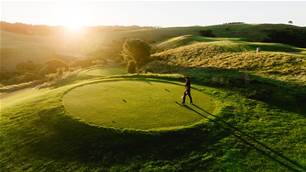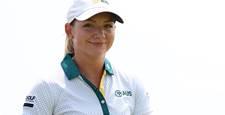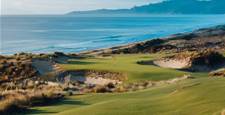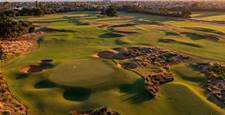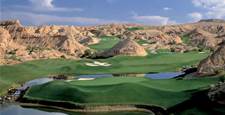There’s something right – elemental, even, if you pardon the pun – to golf by the sea.
There’s something right – elemental, even, if you pardon the pun – to golf by the sea. It’s where the game started, and where it seems to make the most sense. A salty breeze and the sound of crashing waves are the game’s natural accompaniments.
It makes sense, then, that a golf course would tout its proximity to the coast. But for much of its history, the name of the Tuggerah Lakes Golf Club conjured visions of a different kind of water’s edge. For those unfamiliar with the geography of the NSW Central Coast, Tuggerah Lake is a coastal lagoon connected to the nearby sea through a tidal channel. It was on the southern edge of the lake, in Killarney Vale, that the golf club was established in 1930 as a nine-hole layout.
A quarter-century later, the club decided to make a move to a site long considered ideal in the area for an 18-hole course. Although only a couple of kilometres away, the club was now closer to the Tasman than to Tuggerah, perched above the sands of Shelly Beach.
The name stuck for the next 50-plus years, and became synonymous with one of the pre-eminent golf courses of the area, an essential stop for anyone golfing the Central Coast, abetted in no small part by the scenic seaside location. Development in the region led to the emergence of new, residential-driven golfing options in the area, and Tuggerah Lakes was motivated to begin upgrades of its own. Course architect Ross Watson made a set of changes to the course early last decade, while the club has carried onward with new course works as part of a larger overhaul.
A significant part of those changes was the name, to Shelly Beach Golf Club, in mid-2010. The new title has the twin virtues of being geographically correct while also playing up its location, and signals the fresh look that the club is sporting, from its extensively renovated clubhouse to new and redone holes across the layout.
An easy-walking, 6,008-metre par-71 from the tips, Shelly Beach is a prime example of the coastal course conundrum – the holes closer to the water are so good that it makes one tend to overlook the positive qualities of the holes away from it. The layout is divided by Shelly Beach Road, both in a physical and a character sense. The 1st to the 6th and the 15th to 18th are grouped on one side, and share an open, windswept feel that takes in the clear views of the sea. The rest of the holes, six of them on the other side of the road, are characterised by the tighter feel of its tall tree line.
Leading out with a long par-5 and a pair of stout par-4s, the target areas in the fairway appear straightforward off the tee, but the approach into the greens requires thoughtful play. The fairway at the 1st rises to a crest about 120 metres out, enough to obscure a full view of a nicely situated green that rolls off at every edge. The 2nd, a strong, 380-metre, index no.2 test for early in the round, similarly has a sharply featured green with a pronounced right-side shelf to punish any iron shot pushed away from the bunkers on the other side.
The 133-metre 4th is a short par-3, but working back uphill to a narrowing green from front to back, with small bunkers flanking either side. The worst danger here is long – catch a short-iron too pure here and it may end up not too far from the beach, rolling down the hill not too far from the back of the green. From there heading to the 5th and 6h holes, the golfer comes closest to the coast, and players will no doubt linger on the tee box to stare out at the beach and the heads.
The drive off the 5th is blind, compounding the looming presence of out-of-bounds left. The best line from the fairway is down the left, as the approach is influenced by a deep swale fronting the green, with another big greenside bunker on the right.
The 6th is the hole that draws the visitors in, worth the green fee by itself. Unlike the blind 5th, the elevated tee here brings the scrub all the way down the left-side boundary into full view, with the ribbon of the fairway spooling out below. At 337 metres, the play is less than driver – the fairway drops steeply about 100 metres out, with a pond, out of view from the tee, likely to catch any big hitter getting greedy. The green is perched atop a slope, with a sharp right-to-left pitch, placing the premium on accuracy to the last shot.
The 7th starts players off on the parkland-like portion of the course, with a series of holes working back up and down a gentle slope, largely free of fairway bunkering but defined by the strands of pines and spots of ti-tree. The long, two-shotters at the 10th – the table-like, two-tiered green is a standout feature here – 11th and 13th are the tests here, while the 401-metre 14th is a short par-5 and a scoring chance that punctuates this run of holes.
The 15th runs back alongside the 6th, thus sharing the best piece of terrain on the course right below the clubhouse. Like its counterpart, it’s another rolling, short par-4 which will tempt a golfer to blast away from the elevated tee, looking out to the hole below, but is much better off making the precise play down the left-side line of the fairway. The green is set into the side of the slope that runs from the clubhouse to the beach, neatly framing the short-iron approach in – the threat of the front bunker and the presence of the back slope no doubt sends many long, as it did to your correspondent.
The 15th has been better known in the past as Shelly Beach’s (or perhaps Tuggerah Lakes’) 16th, and will eventually become that again. This part of the layout has come in for significant works, as the renovation of the clubhouse forced a change to the old par-3 9th below next to the clubhouse, and a temporary par-3 16th added on the site of the club’s old range. The new 9th is taking shape in this space, and will be a strong par-3 of 160-plus metres that will add to the variety of the course’s one-shotters.
The playing surfaces at Shelly Beach come in for particular notice. The magazine’s visit to the course came only weeks after heavy rains flooded out areas across the layout. However, there wasn’t a hint of that to be found in the fairways, with the drainage qualities of the the course’s sandy loam base plainly one of its great attributes. The greens were also superb, with a true, quick roll accentuating the more interesting putting challenges across the course.
THE COURSE
LOCATION: Shelly Beach Rd,
Shelly Beach, at the end of Wyong Rd, on the NSW Central Coast, about 90 minutes’ drive north of the Sydney CBD.
CONTACT: (02) 4332 3400.
WEBSITE: www.tlgc.com.au
DESIGNERS: Al Howard (1957), Ross Watson (2001), course staff (ongoing).
PLAYING SURFACES: Kikuyu fairways and poa annua greens. The new holes have species of couch in the fairways and bent grass on the greens.
BUNKERS: 57.
PGA PROS: Jason Hart.
GREEN FEES: Between $20 to $45 according to day and time of year.
THE CLUB
MEMBERSHIPS: Full playing memberships are $850 yearly. Separate classes of membership for women, juniors, social and those between 14 and 29 years old also available.
JUNIOR GOLF: The club runs an eight-week clinic for girls and boys between six and 13 years old. There’s also a six-week, small-group clinic for older beginner golfers.
CORPORATE DAYS: The club can provide an event package for fields of up to 144 players. Staff will organise every aspect of the day, including signage, invitations, catering, competitions, prizes, clinics and accommodation if needed.
FACILITIES: The Seaspray Brasserie & Chargrill is based at the club, and is open for lunch every day and dinner from Tuesday to Sunday. With its seaside location on Shelly Beach, the club is popular in the area as a wedding venue, with a large reception room and catering operation.
AWARDS: No.73 in Golf Australia’s Top-100 Public Access courses. Named in Golf Australia’s Top-50 courses you can play for less than $50. Winner of the 2010 NSW City Pro-Am of the Year from the NSW/ACT division of the PGA.
Related Articles
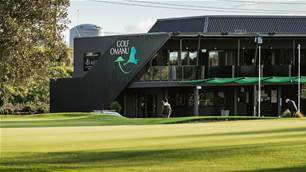
International Spotlight: Omanu Golf Club
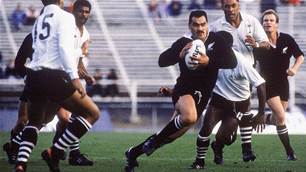
Celebrity Kiwi couple tee off in paradise
